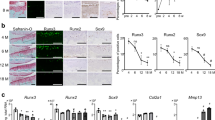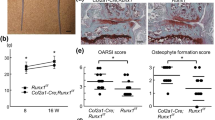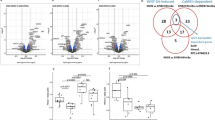Abstract
Osteoarthritis is associated with the irreversible degeneration of articular cartilage. Notably, in this condition, articular cartilage chondrocytes undergo phenotypic and gene expression changes that are reminiscent of their end-stage differentiation in the growth plate during skeletal development1,2. Hedgehog (Hh) signaling regulates normal chondrocyte growth and differentiation3,4,5,6,7,8; however, the role of Hh signaling in chondrocytes in osteoarthritis is unknown. Here we examine human osteoarthritic samples and mice in which osteoarthritis was surgically induced and find that Hh signaling is activated in osteoarthritis. Using several genetically modified mice, we found that higher levels of Hh signaling in chondrocytes cause a more severe osteoarthritic phenotype. Furthermore, we show in mice and in human cartilage explants that pharmacological or genetic inhibition of Hh signaling reduces the severity of osteoarthritis and that runt-related transcription factor-2 (RUNX2) potentially mediates this process by regulating a disintegrin and metalloproteinase with thrombospondin type 1 motif-5 (ADAMTS5) expression. Together, these findings raise the possibility that Hh blockade can be used as a therapeutic approach to inhibit articular cartilage degeneration.
This is a preview of subscription content, access via your institution
Access options
Subscribe to this journal
Receive 12 print issues and online access
$209.00 per year
only $17.42 per issue
Buy this article
- Purchase on Springer Link
- Instant access to full article PDF
Prices may be subject to local taxes which are calculated during checkout




Similar content being viewed by others
Change history
07 January 2010
In the version of this article initially published, the author name Amanda S. Ali was incorrect. The correct name is S. Amanda Ali. The error has been corrected in the HTML and PDF versions of the article.
References
Aigner, T., Soder, S., Gebhard, P.M., McAlinden, A. & Haag, J. Mechanisms of disease: role of chondrocytes in the pathogenesis of osteoarthritis--structure, chaos and senescence. Nat. Clin. Pract. Rheumatol. 3, 391–399 (2007).
Slagboom, E. & Meulenbelt, I. Genetics of osteoarthritis: early developmental clues to an old disease. Nat. Clin. Pract. Rheumatol. 4, 563 (2008).
Mak, K.K., Kronenberg, H.M., Chuang, P.T., Mackem, S. & Yang, Y. Indian hedgehog signals independently of PTHrP to promote chondrocyte hypertrophy. Development 135, 1947–1956 (2008).
Maeda, Y. et al. Indian Hedgehog produced by postnatal chondrocytes is essential for maintaining a growth plate and trabecular bone. Proc. Natl. Acad. Sci. USA 104, 6382–6387 (2007).
Hilton, M.J., Tu, X. & Long, F. Tamoxifen-inducible gene deletion reveals a distinct cell type associated with trabecular bone, and direct regulation of PTHrP expression and chondrocyte morphology by Ihh in growth region cartilage. Dev. Biol. 308, 93–105 (2007).
Kobayashi, T. et al. Indian hedgehog stimulates periarticular chondrocyte differentiation to regulate growth plate length independently of PTHrP. J. Clin. Invest. 115, 1734–1742 (2005).
Vortkamp, A. et al. Regulation of rate of cartilage differentiation by Indian hedgehog and PTH-related protein. Science 273, 613–622 (1996).
Lanske, B. et al. PTH/PTHrP receptor in early development and Indian hedgehog-regulated bone growth. Science 273, 663–666 (1996).
Arai, M. et al. Effect of adenovirus-mediated overexpression of bovine ADAMTS-4 and human ADAMTS-5 in primary bovine articular chondrocyte pellet culture system. Osteoarthritis Cartilage 12, 599–613 (2004).
Mak, K.K. et al. Hedgehog signaling in mature osteoblasts regulates bone formation and resorption by controlling PTHrP and RANKL expression. Dev. Cell 14, 674–688 (2008).
Mainil-Varlet, P. et al. Histological assessment of cartilage repair: a report by the Histology Endpoint Committee of the International Cartilage Repair Society (ICRS). J. Bone Joint Surg. Am. 85-A Suppl 2, 45–57 (2003).
Glasson, S.S. et al. Deletion of active ADAMTS5 prevents cartilage degradation in a murine model of osteoarthritis. Nature 434, 644–648 (2005).
Tchetina, E.V., Squires, G. & Poole, A.R. Increased type II collagen degradation and very early focal cartilage degeneration is associated with upregulation of chondrocyte differentiation related genes in early human articular cartilage lesions. J. Rheumatol. 32, 876–886 (2005).
Lark, M.W. et al. Aggrecan degradation in human cartilage. Evidence for both matrix metalloproteinase and aggrecanase activity in normal, osteoarthritic, and rheumatoid joints. J. Clin. Invest. 100, 93–106 (1997).
Billinghurst, R.C. et al. Enhanced cleavage of type II collagen by collagenases in osteoarthritic articular cartilage. J. Clin. Invest. 99, 1534–1545 (1997).
Parfitt, A.M. et al. Bone histomorphometry: standardization of nomenclature, symbols, and units. Report of the ASBMR Histomorphometry Nomenclature Committee. J. Bone Miner. Res. 2, 595–610 (1987).
Krenn, V. et al. Synovitis score: discrimination between chronic low-grade and high-grade synovitis. Histopathology 49, 358–364 (2006).
Goodrich, L.V., Milenkovic, L., Higgins, K.M. & Scott, M.P. Altered neural cell fates and medulloblastoma in mouse patched mutants. Science 277, 1109–1113 (1997).
Hopyan, S. et al. A mutant PTH/PTHrP type I receptor in enchondromatosis. Nat. Genet. 30, 306–310 (2002).
Jeong, J., Mao, J., Tenzen, T., Kottmann, A.H. & McMahon, A.P. Hedgehog signaling in the neural crest cells regulates the patterning and growth of facial primordia. Genes Dev. 18, 937–951 (2004).
Grover, J. & Roughley, P.J. Generation of a transgenic mouse in which Cre recombinase is expressed under control of the type II collagen promoter and doxycycline administration. Matrix Biol. 25, 158–165 (2006).
Ho, L. et al. Gli2 and p53 cooperate to regulate IGFBP-3- mediated chondrocyte apoptosis in the progression from benign to malignant cartilage tumors. Cancer Cell 16, 126–136 (2009).
Zhang, X.M., Ramalho-Santos, M. & McMahon, A.P. Smoothened mutants reveal redundant roles for Shh and Ihh signaling including regulation of L/R symmetry by the mouse node. Cell 106, 781–792 (2001).
Romer, J.T. et al. Suppression of the Shh pathway using a small molecule inhibitor eliminates medulloblastoma in Ptc1(+/−)p53(−/−) mice. Cancer Cell 6, 229–240 (2004).
Williams, J.A. et al. Identification of a small molecule inhibitor of the hedgehog signaling pathway: effects on basal cell carcinoma-like lesions. Proc. Natl. Acad. Sci. USA 100, 4616–4621 (2003).
Hopyan, S., Nadesan, P., Yu, C., Wunder, J. & Alman, B.A. Dysregulation of hedgehog signalling predisposes to synovial chondromatosis. J. Pathol. 206, 143–150 (2005).
Tiet, T.D. et al. Constitutive hedgehog signaling in chondrosarcoma up-regulates tumor cell proliferation. Am. J. Pathol. 168, 321–330 (2006).
Sarangi, A. et al. Targeted inhibition of the Hedgehog pathway in established malignant glioma xenografts enhances survival. Oncogene 28, 3468–3476 (2009).
Thirunavukkarasu, K., Pei, Y. & Wei, T. Characterization of the human ADAMTS-5 (aggrecanase-2) gene promoter. Mol. Biol. Rep. 34, 225–231 (2007).
Kamekura, S. et al. Contribution of runt-related transcription factor 2 to the pathogenesis of osteoarthritis in mice after induction of knee joint instability. Arthritis Rheum. 54, 2462–2470 (2006).
Shimoyama, A. et al. Ihh/Gli2 signaling promotes osteoblast differentiation by regulating Runx2 expression and function. Mol. Biol. Cell 18, 2411–2418 (2007).
Takamoto, M. et al. Hedgehog signaling enhances core-binding factor a1 and receptor activator of nuclear factor-kappaB ligand (RANKL) gene expression in chondrocytes. J. Endocrinol. 177, 413–421 (2003).
Li, Y. et al. Transduction of passaged human articular chondrocytes with adenoviral, retroviral, and lentiviral vectors and the effects of enhanced expression of SOX9. Tissue Eng. 10, 575–584 (2004).
Ng, T.C., Chiu, K.W., Rabie, A.B. & Hagg, U. Repeated mechanical loading enhances the expression of Indian hedgehog in condylar cartilage. Front. Biosci. 11, 943–948 (2006).
Adams, M.E., Matyas, J.R., Huang, D. & Dourado, G.S. Expression of proteoglycans and collagen in the hypertrophic phase of experimental osteoarthritis. J. Rheumatol. Suppl. 43, 94–97 (1995).
Adams, S.L., Cohen, A.J. & Lassova, L. Integration of signaling pathways regulating chondrocyte differentiation during endochondral bone formation. J. Cell. Physiol. 213, 635–641 (2007).
Yoshida, C.A. et al. Runx2 and Runx3 are essential for chondrocyte maturation, and Runx2 regulates limb growth through induction of Indian hedgehog. Genes Dev. 18, 952–963 (2004).
Wunder, J.S., Nielsen, T.O., Maki, R.G., O'Sullivan, B. & Alman, B.A. Opportunities for improving the therapeutic ratio for patients with sarcoma. Lancet Oncol. 8, 513–524 (2007).
Steinert, A.F. et al. Major biological obstacles for persistent cell-based regeneration of articular cartilage. Arthritis Res. Ther. 9, 213 (2007).
Everts, V. & Buttle, D.J. Methods in studying ECM degradation. Methods 45, 86–92 (2008).
Taniguchi, H. et al. Transcriptional silencing of hedgehog-interacting protein by CpG hypermethylation and chromatic structure in human gastrointestinal cancer. J. Pathol. 213, 131–139 (2007).
Acknowledgements
We wish to thank D. Backstein and A. Gross (Mount Sinai Hospital, Toronto) for assistance obtaining human cartilage samples, T. Mak (University Health Network, Toronto) for assistance obtaining the hedgehog blocking agent, L. Morikawa for assistance with sectioning and histology, P. Roughley (McGill University) for providing the COL2-rtTA-Cre mice and R. Ward and C.-C. Hui for their assistance with the Ptch1+/− mice. The Canada Research Chair program supports B.A.A. A.C.L. and C.H. are supported by Canadian Institutes of Health Research studentships; L.H. and S.A.A. are supported by Ontario graduate scholarships. This work was supported by the Canadian Institutes of Health Research grant FRN: 79436.
Author information
Authors and Affiliations
Contributions
A.C.L. and B.A.A. designed the experiments, interpreted the data and wrote the manuscript. A.C.L. performed the experiments with the assistance of B.L.S., J.M.B. and M.A.K., who helped with the mouse experiments; H.W., who performed histology and immunostaining; L.H., who performed siRNA experiments; and C.H. and S.A.A., who performed RNA expression studies. B.A.A. supervised the project.
Corresponding author
Supplementary information
Supplementary Text and Figures
Supplementary Tables 1–4 and Supplementary Figures 1–4 (PDF 908 kb)
Rights and permissions
About this article
Cite this article
Lin, A., Seeto, B., Bartoszko, J. et al. Modulating hedgehog signaling can attenuate the severity of osteoarthritis. Nat Med 15, 1421–1425 (2009). https://doi.org/10.1038/nm.2055
Received:
Accepted:
Published:
Issue Date:
DOI: https://doi.org/10.1038/nm.2055
This article is cited by
-
SCP2 mediates the transport of lipid hydroperoxides to mitochondria in chondrocyte ferroptosis
Cell Death Discovery (2023)
-
Primary cilia support cartilage regeneration after injury
International Journal of Oral Science (2023)
-
Deletion of DYRK1A Accelerates Osteoarthritis Progression Through Suppression of EGFR-ERK Signaling
Inflammation (2023)
-
An integrated in silico-in vitro approach for identifying therapeutic targets against osteoarthritis
BMC Biology (2022)
-
Current understanding of osteoarthritis pathogenesis and relevant new approaches
Bone Research (2022)



